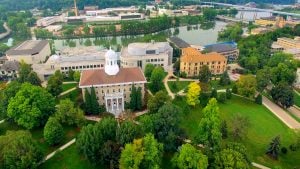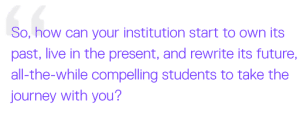
Embracing change has been a common theme in higher ed so far this year. Everybody’s talking about the work by a researcher out of Carleton College, who formulated the Higher Education Demand Index, or HEDI. In case you missed it, HEDI suggests enrollment, especially at less selective colleges, won’t survive a decline in degree-seeking students if they continue to ignore the data and turn to status quo solutions (e.g., engaging more target populations like veterans, out of state students, international students). Similarly, the Lawlor Group’s trends for 2018 foreshadowed the longer-term predictions of HEDI and offer compelling reasons for higher education institutions to stop doing the same things expecting different results. However, the core issues remain unaddressed by all of these publications: finding institutional identity today through the uncertainty of tomorrow.

Another (disgruntled?) professor at University of Notre Dame suggested that higher education is suffering from a lack of integrity – drowning in a pool of our own problems created by short-term thinking, commercialization, dichotomizing liberal and practical arts, and deterrence to unexamined practices in the name of “tradition.” Although I don’t necessarily agree with portions of this moral argument, the theme of “being all things to all people is not working” is clear. As an industry, we are facing a crisis of creativity and are lacking the courage to do things differently.
Where to start? Higher ed – I sympathize. It feels like the deck is stacked. Similar to the start of the new year, I can look at the scale, my post-holiday bank account, my messy apartment, my bare fridge, my untackled to-do list for starting my dissertation again… and know all the things I “should” address and the risks of resisting positive change. But how do I make changes that will last far beyond January, and what should I prioritize?
In the spirit of the new year and given our current political context, I’ve been thinking more and more about the importance of “identity” when it comes to personal and organizational change. The centrality of who we are and who we are becoming is at the heart of both the individual and the collective pursuit of education.

To make sense of our existence, we often turn to narrative. Humans are wired for stories and, as the people who comprise institutions, it makes sense that organizations create meaning through their stories, too. Right now, there’s a difficult story being told about higher education, one that commands a variety of responses. It may be easy to ignore, deny, or despair population trends, antiquated practices, or internal contradictions that are crying for higher education reform. However, I am a big fan of Brené Brown, the acclaimed research professor at the University of Houston Graduate College of Social Work. After reading practically everything Brené Brown has ever published, including this blog post, I have found her to be accurate in that: “When we deny our stories, they define us. When we own our stories, we get to write a brave new ending.”
I’d be crazy to believe that there’s some silver bullet to addressing all the challenges facing higher education. But, I do believe that institutions must start with a clear story about who they are, and who they are uniquely becoming, in order to begin tackling those challenges. Without a doubt, this requires difficult internal work. Let’s make a stand and put an end to conformity in higher education once and for all. Comparison may be helpful for assessment and benchmarking, but it kills all innovation and imagination.

It’s true, predictive research forecasts like those cited earlier can become a reality – but that’s only if institutions maintain their status quo. Only uniqueness and transformation can help redesign the future of higher education, while simultaneously redesigning the student experience. So, how can your institution start to own its past, live in the present, and rewrite its future, all-the-while compelling students to take the journey with you?
Again, I turn to Brené Brown. Her publication, Rising Strong, offers steps to developing your identity when you’ve overcome something, failed, and need to bounce back. Using her three-step framework, I think that schools struggling to make sense of who they are can find a way to reclaim their unique institutional identity in these changing times.
Step One: “Reckon” with your emotions and get curious about what you’re feeling.
So, as an institution, what are our pain points in our narratives? Is there something specific about these criticisms of higher education that make us feel something, especially something uncomfortable? When do you notice people getting quiet, defensive, or walking on eggshells in meetings? What topics do you try to avoid discussing on campus tours? Did a vendor or consultant ever have an observation about your school or processes that struck a nerve? How can we lean into these “off limits” spaces instead of ignoring or numbing them?
Step Two: “Rumble” with the stories you may be telling about yourself until you get to your truth.
For an institution, this means exercising some critical thinking about the situations and people – both within and outside of the school – who have played roles in writing our toughest stories to date. What is the false truth behind these feelings of discomfort, and what is the real truth? Is there a different way to look at difficult situations? Could we apply a learning-orientation or growth mindset to our failures? Is there something in the story that puts a shared, core value at risk? Have we excluded some people or groups from the formal story to tell a more flattering, whitewashed, or dominant one? Are we living, risk-averse and ashamed, in the shadows of one past shortfall from an enrollment, budget, or hiring decision? How do we continue the narrative of our institutional identity in a way that feels authentic to the true story?
Step Three: Live this process, every day, until it becomes a practice and creates nothing short of a “revolution.”
What themes can we harness and transform into positive, distinct perspectives that will differentiate us for years to come? How do we become more inclusive of people who were on the margins of our stories, like students, people of color, and emergent scholarships? Can we be brave enough to engage in the tough work of speaking up every day in meetings, naming our discomfort, and leading our institutions through vulnerability to a position of strength? What values have we identified in our stories that we can put into practice daily that will endure these challenges and changing times?
When reading all of this year’s reports and predictions out there for higher ed, it can feel like the industry is doomed if we stay the current course. Yet, I believe that with the new year brings new beginnings. Amid the resuming of classes, application waves, and flurry of prospecting activity, let’s find time to pause and reflect. The data is clear: it’s absolutely urgent that we make time to consider questions of institutional identity, now, before it’s too late.
It’s from a strong sense of personal and institutional identity that we can foster the kind of motivation and integrity required to serve students while withstanding the changes and challenges present in our field. So, if you’re looking for some inspiration to get started on those New Year’s resolutions (both personally and professionally), let it be this: “Integrity is choosing courage over comfort; choosing what is right over what is fun, fast, or easy; and choosing to practice our values rather than simply professing them.” (Brené Brown, Rising Strong).
